The Living Planet Report documents the state of the planet—including biodiversity, ecosystems, and demand on natural resources—and what this means for humans and wildlife. Published by WWF every two years, the report brings together a variety of research to provide a comprehensive view of the health of the earth.

Population sizes of vertebrate species—mammals, birds, reptiles, amphibians, and fish—have declined by 52 percent over the last 40 years. In other words, those populations around the globe have dropped by more than half in fewer than two human generations.
At the same time, our own demands on nature are unsustainable and increasing. We need 1.5 Earths to regenerate the natural resources we currently use; we cut trees faster than they mature, harvest more fish than oceans replenish, and emit more carbon into the atmosphere than forests and oceans can absorb.



